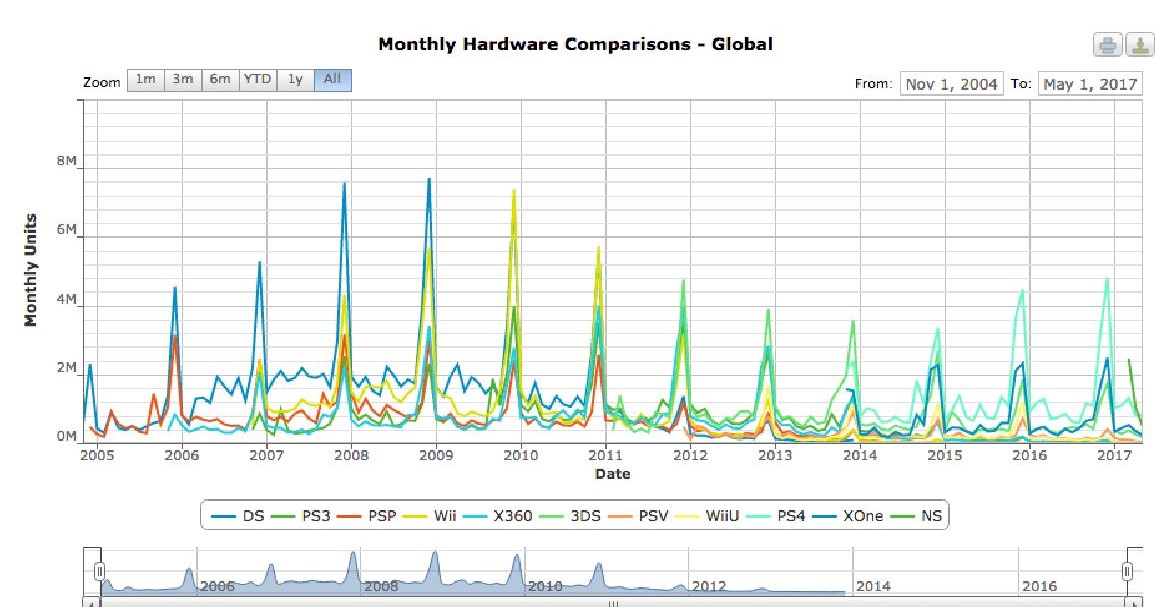
What’s Old Is New Again?
The Issue of Overlapping Console Releases
If you grew up surrounded by video games, one thing is becoming increasingly clear: your childhood is never going to end. once thought of as a fad, a waste of time, and an easy way to get yelled at for not doing your homework, video game consoles are evolving to become the centrepiece of home entertainment systems that children and parents can enjoy. they can do more than just play video games; internet connectivity and bluray playback are now standard. When consoles do perform their original function, they do with an ever-improving ability to render graphics. over the next few years, manufacturers will make 4k resolution the norm, and game makers will rise to meet them.
the world of video game development is a competitive one, and companies such as Nintendo, sony, and microsoft are constantly striving to stay visible. case in point: the latter two companies in that list have new releases out this year. In June, microsoft announced an update of its xbox one, named the xbox one x, for release this coming November. While not officially a brand new console, you would be forgiven for thinking otherwise as the one x boasts an expanded graphics processing unit (GpU) and native 4k support.If you grew up surrounded by video games, one thing is becoming increasingly clear: your childhood is never going to end. once thought of as a fad, a waste of time, and an easy way to get yelled at for not doing your homework, video game consoles are evolving to become the centrepiece of home entertainment systems that children and parents can enjoy. they can do more than just play video games; internet connectivity and bluray playback are now standard. When consoles do perform their original function, they do with an ever-improving ability to render graphics. over the next few years, manufacturers will make 4k resolution the norm, and game makers will rise to meet them. the world of video game development is a competitive one, and companies such as Nintendo, sony, and microsoft are constantly striving to stay visible. case in point: the latter two companies in that list have new releases out this year. In June, microsoft announced an update of its xbox one, named the xbox one x, for release this coming November. While not officially a brand new console, you would be forgiven for thinking otherwise as the one x boasts an expanded graphics processing unit (GpU) and native 4k support.
sony, meanwhile, is taking the idea of staying visible more literally. on the heels of microsoft’s announcement, sony announced that it would be re-releasing its playstation 4 console in gold and silver colours. though the re-release comes with no technological updates of note, the playstation 4 pro was released in November 2016, which is also capable of 4k graphics rendering.
It would seem that microsoft have scored a major coup over sony in the console wars, were it not for the fact that microsoft had released a strikingly similar console in 2016: the xbox one s, which already had some 4k support. although one x now features the best GpU (6.0 teraflops compared to the PS4 Pro’s 4.2), it would seem like microsoft is now competing against itself. other analysts have also noted this confusing development. It begs the question: do console updates actually help the overall sales of hardware?

In answering this question by analyzing month-on-month worldwide sales of video game consoles in recent years, it appears that game hardware manufacturers frequently step on their own toes in releasing updates of their consoles. Nintendo’s beloved Wii was released in 2006 to widespread acclaim, and a miniature model of of the Wii was released at the end of 2012. Not counting the christmas holiday sales spike (so, sales for the months of November, December, and January), the Wii mini helped sales to even out, selling 184,886 units in october 2012 and 187,968 in february 2013. However, sales declined to 83,751 by october 2013. It is possible it conclude that this decline was brought about, at least in part, by the November 2012 release of the WII U, which began outselling the original Wii almost from the word ‘go’.
It would seem that Nintendo has learned something from its Wii experience, and concluded that overlaps between releases of up
dates to prior consoles and releases of brand new consoles are not a good idea. prior to the release of the switch in march 2017, Nintendo discontinued support entirely for the Wii U. If nothing else, this move has allowed the video game giant to focus entirely on its brand new product, which has enjoyed wild success in just a few short months.
sony and microsoft are multifaceted companies of which video games are just a part, so they may pay no mind to the carelessness with which they offer new and updated consoles. If they ever need to rethink their release strategy, however, Nintendo has offered a modest example

